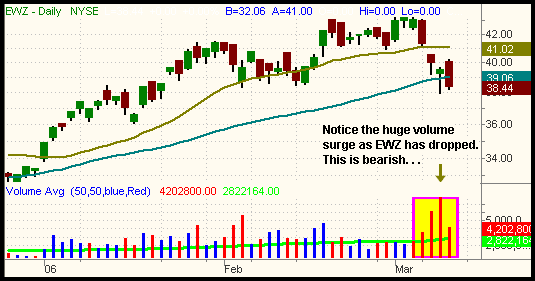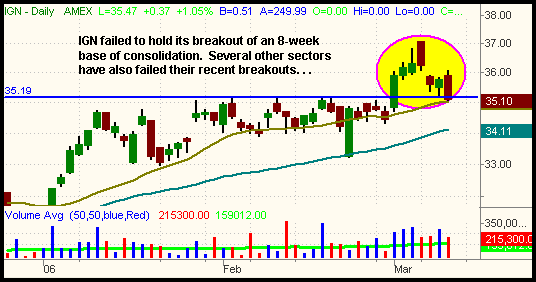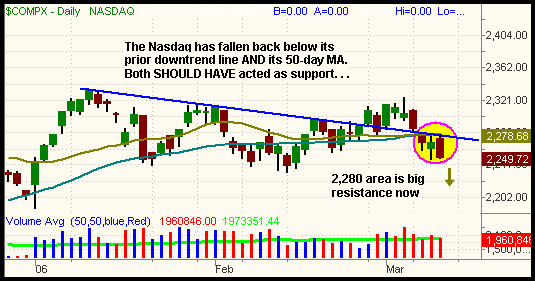Above all, remember this…
After a feeble rally attempt in the
first thirty minutes of trading, the bears quickly took control
yesterday, causing stocks to trend steadily lower throughout the session and
finish with broad-based losses. The Nasdaq Composite
(
COMP |
Quote |
Chart |
News |
PowerRating) again showed
the most relative weakness and fell 0.8%. The S&P 500
(
SPX |
Quote |
Chart |
News |
PowerRating), S&P Midcap 400,
and small-cap Russell 2000 indices each lost 0.5%, while the Dow Jones
Industrials
(
DJX |
Quote |
Chart |
News |
PowerRating) dropped 0.3%. Each of the major indices finished at their
intraday lows. Because institutions usually make their moves in the final hour
of trading, this tells us there was a complete lack of institutional support
into the close. Our short entry in MDY triggered yesterday, as we shorted the
rally into new resistance of its 50-day moving average.
Total volume in the NYSE declined by 12% yesterday, while
volume in the Nasdaq was 7% lower than the previous day’s level. Although it is
positive that the market’s losses occurred on lighter volume, the intraday
pattern was much the same as the previous day. Specifically, volume was on pace
to be even lighter after the initial morning rally, but turnover increased as
the market subsequently trended lower. Market internals similarly made a bearish
u-turn as the day progressed. In the morning, advancing volume in the NYSE
exceeded declining volume by more than 2 to 1, but the ratio was negative
by nearly 2 to 1 at day’s end.
While scanning the extensive list of ETFs we follow on a daily
basis, we were hard pressed to find a single ETF that looks like a clear buy
setup. Even international ETFs that have been outperforming the U.S. markets
have begun to correct sharply. Two such examples are FXI (iShares Xinhua China
25 Fund) and EWZ (iShares Brazil). Taking a look at EWZ, one of the best
performing ETFs this year, notice how it closed yesterday below its 50-day
moving average for the first time since last October. However, the one
difference between this time and last October’s correction is that the drop of
the past week has been on huge volume:

The massive volume in EWZ in recent days tells us it is under
institutional distribution. Even though ETFs are pegged to the price of their
underlying stocks and move accordingly, we have found that an ETF’s volume
pattern usually matches the volume patterns of the underlying stocks as well.
In addition to weakness in the international ETFs, many
industry sectors have failed their recent breakouts as well. One such example is
IGN, the iShares ETF that mirrors the Goldman Sachs Networking Index. After
consolidating at its high and in a tight range for eight weeks, IGN eventually
broke out to a new 52-week high on March 1. Because the consolidation was so
long, the breakout should have been powerful and sustainable, but now it has
fallen back into its range only six days later:

Going into yesterday, the broad market was positioned to
follow-through on the previous day’s bullish reversal attempt, but buyers were
nowhere to be found. As a result, the S&P 500 gave back nearly all of the
previous afternoon’s gains and fell back below its 50-day moving average. The
Nasdaq was unable to rally back above its 50-day MA in the morning, and
subsequently fell all the way down to its low of the previous day. It’s also
interesting to note that the Nasdaq now has additional overhead resistance of
its prior downtrend line from the January 11 high. When the Nasdaq began to drop
on March 3, it should have found support at its prior downtrend line, but
it quickly fell back below it. The reason it should have found support is
that the most basic tenet of technical analysis states the following: a prior
resistance level becomes the new support level after that resistance is broken
(and vice versa). We have illustrated the prior downtrend line that failed to
hold as support:

In addition to yesterday’s negative action in the major
indices, we once again saw a complete lack of sector leadership, as well as the
continued breakdown of many former leading stocks. Needless to say, all these
factors do not bode well for the short-term direction of the broad markets. With
so many industry sectors failing their recent breakouts or falling below support
of their primary uptrend lines, trying to swim against the tide by going long
does not make sense. As always, be sure to honor your stops because we
feel it is risky to be long right now. If you are sitting on a losing position,
don’t let a small or moderate loss turn into one that causes major damage to
your account. Above all, remember to “trade what you see, not what you think!”
Open ETF positions:
Short MDY (regular subscribers to
The Wagner Daily
receive detailed stop and target prices on open positions and detailed setup
information on new ETF trade entry prices. Intraday e-mail alerts are also sent
as needed.)
Deron Wagner is the head trader of Morpheus Capital Hedge Fund and founder of
Morpheus Trading Group (morpheustrading.com),
which he launched in 2001. Wagner appears on his best-selling video, Sector
Trading Strategies (Marketplace Books, June 2002), and is co-author of both The
Long-Term Day Trader (Career Press, April 2000) and The After-Hours Trader
(McGraw Hill, August 2000). Past television appearances include CNBC, ABC, and
Yahoo! FinanceVision. He is also a frequent guest speaker at various trading and
financial conferences around the world. For a free trial to the full version of
The Wagner Daily or to learn about Deron’s other services, visit
morpheustrading.com or send an e-mail to
deron@morpheustrading.com .
Â
Â
Â
